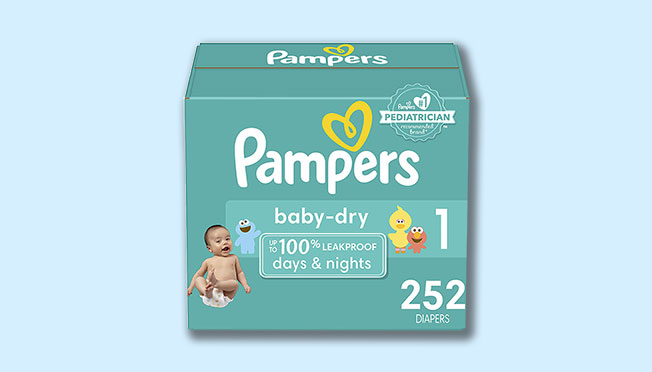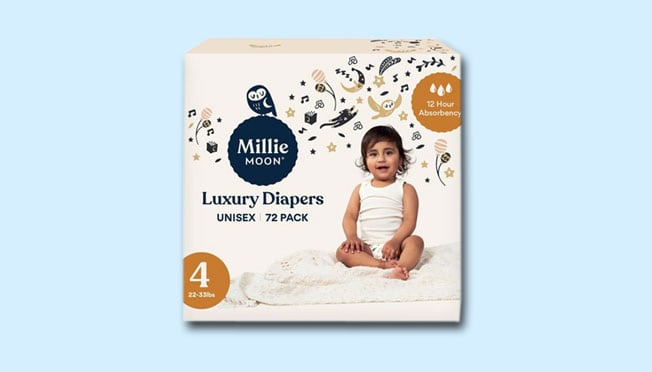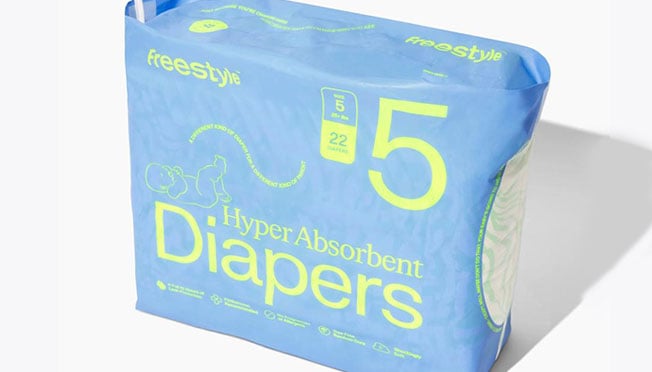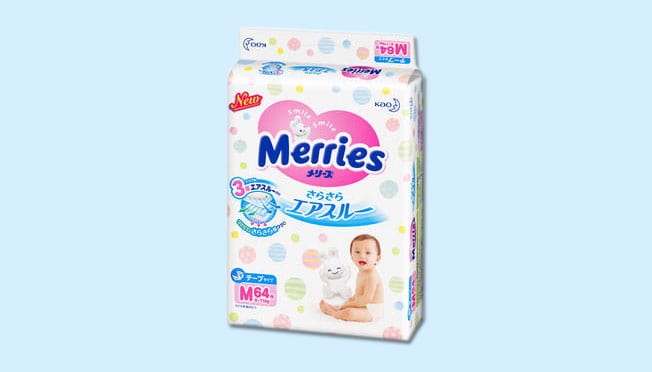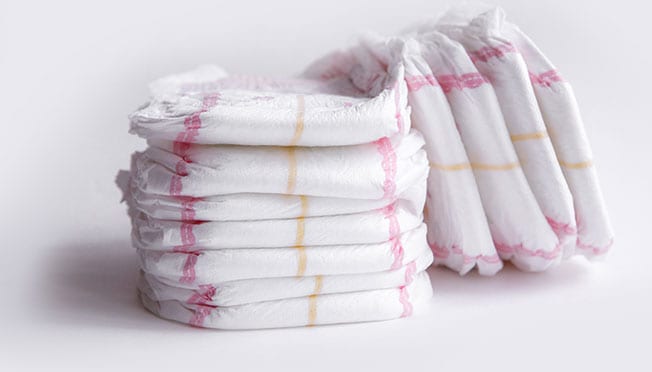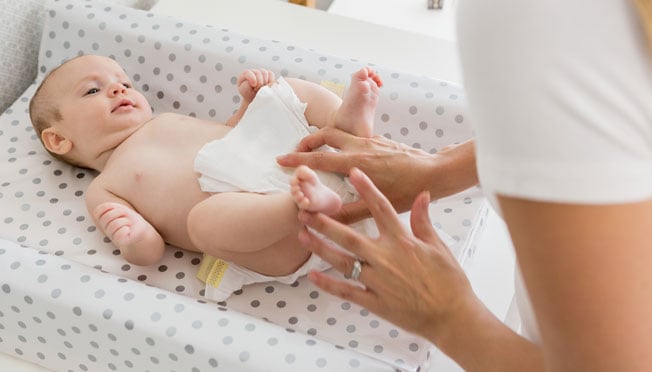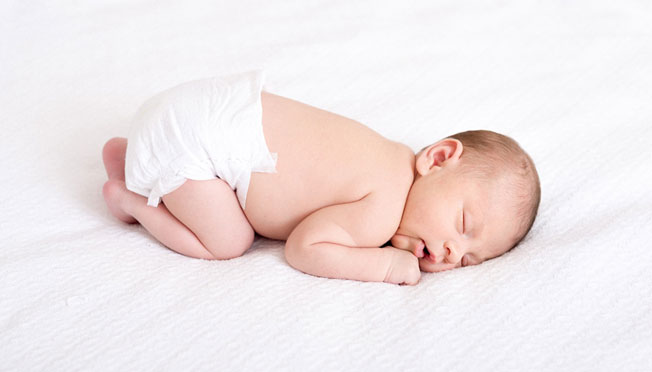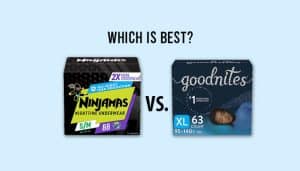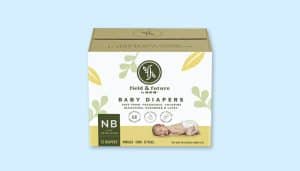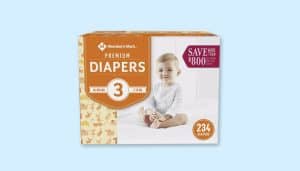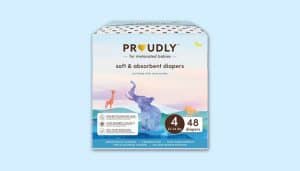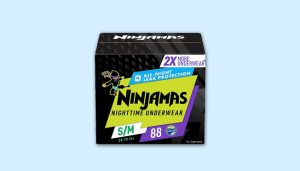Pampers is still one of the world’s best-known diaper brands. Widely available across the globe, you’d be forgiven for thinking Pampers offers the best for our little ones.
While it’s fair to say that Pampers diapers are effective, the company leaves a lot to be desired when it comes to their use of chemicals.
Parents are waking up to the realities of diapers and how unhealthy they can be. So how do one of Pampers’ most popular varieties fare?
Let’s take a closer look at Pampers Baby Dry!
Disclaimer: Huggies Diapers has not sponsored or endorsed this article in any way. As a mom who’s passionate about buying the best for babies, I try really hard to include accurate information in all of my posts. If there are any inaccuracies present, please let me know; I’m more than happy to amend any errors. For more information about Huggies Diapers, head over to their main sites: huggies.com. This review has affiliate links. I may receive a small commission at no extra cost to you if you make a purchase through my affiliate link. Please read my disclosure for more info.

Pampers Baby Dry Features
Pampers Baby Dry diapers boast features you’d expect from a variety called ‘Baby Dry’! They’re ‘up to 100% leakproof’ (which is a strange way of saying they may or may not prevent leaks!), have stretchy sides, LockAway channels and a Dri-Weave Liner.
All of this just means they’re very absorbent.
What are Pampers Baby Dry made of?
As we become conscious of the impact our purchases have on the environment, more and more diaper brands are offering eco-friendlier alternatives. Some brands are now moving away from using petroleum-based plastics to using more plant-based materials, like bamboo and wood.
You might assume Pampers would be making the same effort. Unfortunately, they’re not.
The vast majority of their diaper varieties still use mainly petroleum-based plastics, and contain unnecessary chemicals too.
The brand lets us know that their diapers don’t contain certain chemicals, like mercury, lead and latex. But that leaves completely unnecessary chemicals like phthalates, fragrances and lotions, found in many of their diaper varieties.
It’s completely unnecessary to add lotions and fragrances to baby diapers, and they could easily irritate sensitive skin. Read more about why it’s important to avoid these chemicals here!
Let’s see a breakdown of what’s really inside Baby Dry diapers:
Topsheet (inner layer) – Polypropylene Nonwoven
Backsheet (outer layer) – Polypropylene and Polyethylene
Acquisition Layer (under the topsheet) – Polyester
Absorbent Core – Elemental chlorine-free fluff pulp and SAP
*Information above is from SmartLabel.org
What is inside Pampers Baby Dry: Are Pampers Baby Dry Toxic?
It’s important to know what diaper brands stay away from. And there’s a long list of chemicals they should certainly avoid!
I’d advise all parents and carers to choose diapers which are free of phthalates, fragrances, lotions, dyes and chlorine. Read more about why it’s important to avoid them here. So let’s take a closer look at Pampers Baby Dry.
Pampers is clear that all of their diaper varieties are free of latex and parabens, but they don’t say anything about fragrances, phthalates, lotions, dyes and chlorine on the packaging. You need to dig deeper to find this information. If a brand doesn’t make it super clear that they’re free of a certain toxin, it’s safer to assume it’s used.
| Fragrances Used? | Yes. |
| Dyes Used? | Yes (No disperse dyes, no lead and mercury in printed inks) |
| Lotion Used? | Yes (Made with petrolatum, aloe barbadensis leaf extract and stearyl alcohol) |
Do Pampers Baby Dry have chlorine?
Pampers says its diapers are free of elemental chlorine, but that doesn’t mean that they’re free of chlorine completely. It means that the elemental chlorine is not used in their production. Instead, a chlorine derivative, called chlorine dioxide is used. This process reduces dioxins amounts but not completely eliminates them. The best diapers are those which are totally chlorine free, because bleaching diapers is terrible for the environment.
More on this topic: Disposable Diapers: What Are They Made From, And Are They Safe?
Where Pampers Baby Dry are made?
Pampers varieties are made in manufacturing plants all around the world.
Pampers Baby Dry price
The price of Baby Dry diapers will vary, depending on where you get them. The price chart below gives you an idea of what you might expect to pay. All prices below are from Amazon.
It’s fair to say that Baby Dry diapers aren’t super budget friendly, but they’re cheaper than some premium diapers.
| Size | Price per diaper |
| N | 26 cents |
| 1 | 23 cents |
| 2 | 24 cents |
| 3 | 30 cents |
| 4 | 29 cents |
| 5 | 29 cents |
| 6 | 38 cents |
*Prices were accurate at the time this article was published but may change over time.
Pampers Baby Dry Size Chart
Pampers Baby Dry diapers are available in sizes newborn to 6.
| Size | Weight |
| N | >10lbs |
| 1 | 8-14lbs |
| 2 | 12-18lbs |
| 3 | 16-28lbs |
| 4 | 22-37lbs |
| 5 | 27lbs+ |
| 6 | 35lbs+ |
What Customers Say: Pampers Baby Dry reviews
Pampers Baby Dry diapers are a very popular diaper variety in the US. And it’s safe to say that reviews are pretty glowing. They score an average of 4.8 out of 5 in over 38,000 reviews on Amazon, with parents and carers saying they’re super effective at preventing leaks. A few users say they’re not the best for overnights, but overall, reviews are very positive.
Where to buy Pampers Baby Dry
You’ll find Pampers Baby Dry on Amazon, online at Walmart and Target and at grocery stores across the country. You’ll probably even find them at small convenience stores. Personally, I like having my diapers delivered to my door, sometimes as part of a subscription service (read about my favorites here), but Pampers doesn’t offer a similar service.
Read Next: 14 Best Diaper Delivery Services: Comparisons & Reviews
What can I buy instead of Pampers Baby Dry – Pampers Baby Dry alternatives
It’s not enough for diapers to be effective anymore. We throw away more than 20 billion disposable diapers every year, most of which are made of petroleum-based plastics. And we know how terrible this is for the world around us, and for our little ones’ futures.
There are so many amazing alternatives to Pampers Baby Dry that provide the same level of leak protection, but without the harsh chemicals (and often with more plant-based materials).
Some of my favorite toxin-free, reasonably-priced diapers include Abby & Finn and Hello Bello. Both brands are available on subscription, so you can get them delivered straight to your door.
If you’re looking for diapers that avoid harsh chemicals and use more plant-based materials, look for biodegradable diapers. These diapers are made with a high percentage of plant-based materials and break back down into the soil in a matter of months or a few years, depending on the conditions.
Check out my guide to the best biodegradable diapers for some of my favorite brands, including Eco Pea, Ecoriginals and Dyper!
Related Post: Dyper Diapers Review: Eco-Friendly, Skin-Friendly And Bank Account-Friendly
Read Next: Ecoriginals Diapers Review, 2023: The Greenest Diaper On The Market?
Pampers Baby Dry FAQ
1. Why are Pampers Baby Dry so thin?
Diaper brands change and adapt their diaper varieties all the time, to optimize fit and effectiveness. Some reviews online say that Baby Dry diapers are noticeably thinner now than they were years ago. That could be the case, especially as technology improves and diapers become even more absorbent.
Some other reviews have noted that Baby Dry diapers aren’t the softest, so might not be that comfortable for your little one.
If you’re looking for a super soft diaper, check out Eco Pea. This brand’s changing the game with super soft and sustainable diapers that won’t break the bank.
Related Post: Eco Pea Diapers Review: Super Soft, Sustainable And Saving The Planet
2. Do Pampers Baby Dry leak?
Pampers tells us that their Baby Dry diapers are ‘up to 100% leakproof’, which you could say is true of all diapers! Your baby is unique, so it’s not necessarily the case that what works for another parent will work for you. Babies come in all shapes and sizes, after all.
The majority of Baby Dry reviews say that the diapers are good at preventing leaks, which you’d expect. Some say they have experienced leaks. It’s always important to find the right size of diaper to minimize the chance of leaks and the dreaded poosplosions!
3. How long do Pampers Baby Dry last?
How long diapers will ‘last’ varies from variety to variety. But most manufacturers recommend using diapers within a couple of years from purchasing them. As time goes on, diapers may become discolored and become less effective at keeping the pee and poop at bay.
4. What’s the difference between Pampers Baby Dry and overnight?
Pampers Baby Dry and Pampers Swaddlers Overnights seem pretty similar. Both say they’ll keep your baby dry for up to 12 hours, so they’re suitable for overnights and both feature stretchy sides, LockAway channels and a breathable liner.
You might struggle to find Swaddlers Overnights in all grocery stores, but they are available on Amazon. You might also find that Swaddlers Overnights are a little more expensive than Baby Dry. On Amazon, expect to pay about 30 cents per diaper for size 3 Baby Dry diapers. Pampers Swaddlers Overnights, on the other hand, will set you back about 37 cents per diaper (size 3).
5. What’s the difference between Baby Dry and Cruisers?
While Pampers Baby Dry diapers come in sizes N-6, Cruisers are suitable for babies on the move. They’re available in sizes 3-7. Again, they’re widely available, but a little more expensive than Baby Dry. And they also contain chemicals like phthalates, fragrances and lotions.
Pampers Baby Dry vs Pure Protection
Pampers Pure Protection diapers are Pampers’ only variety that uses some plant-based materials. We’re not told what percentage of the diaper is plant-based, however. Unlike Baby Dry, Pure Protection diapers are free of chlorine, fragrances and lotions.
They’re pretty widely available, although you might find that they’re a little more expensive than Baby Dry diapers. They’re more than worth it if you’re a Pampers fan and budget can stretch to it, though!
Read Next: Pampers Pure Protection Review: Are They Really Pure?
Pampers Baby Dry vs Swaddlers
Pampers Swaddlers focus on softness, whereas Baby Dry diapers focus on just that – keeping baby dry! Both diaper varieties use petroleum-based plastics and contain unnecessary added toxins like phthalates and fragrances.
Both varieties are widely available and come out at a pretty similar price too.
Is Pampers Baby Dry same as Luvs?
Pampers Baby Dry diapers share a lot of similarities with Luvs; both should be suitable for overnights, as both focus on their superior absorbency. Luvs tells us that their diapers can hold up to 20x their weight!
Luvs also tend to be a lot cheaper than Pampers.
Related Post: Luvs Vs Pampers: Which Diaper’s Best?
The Good, The Bad and the Bottom Line of Pampers Baby Dry
The Good
The Bad
Conclusion: Are Pampers Baby Dry Good?
A diaper now has to do more than keep pee and poop at bay to be considered ‘good’. There are plenty of effective diapers that keep your little one dry and comfortable, sometimes for up to 12 hours.
But we have to start focusing more on what’s inside disposable diapers – the chemicals they contain and what they’re made of. Do they use any plant-based materials? Do they make any effort to safeguard our little ones’ futures?
Unfortunately, Pampers are way behind in the race to produce the best diapers.
Like many of their varieties, Baby Dry diapers are made predominantly with petroleum-based plastics and contain potentially harmful chemicals like fragrances, lotions and phthalates.
There are so many brands on the market that offer diapers which will keep your little one’s skin dry, and make a difference to their future.
But Pampers isn’t one of them.
Related Reading

